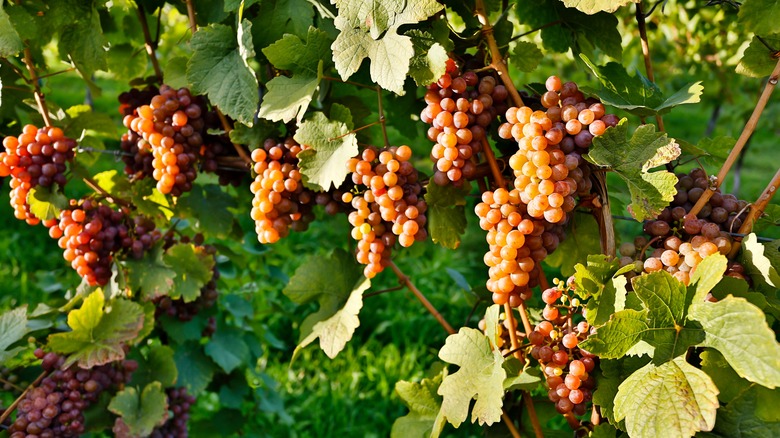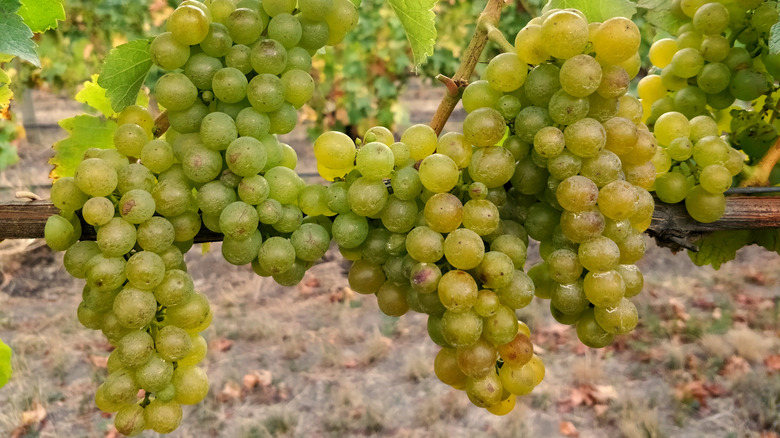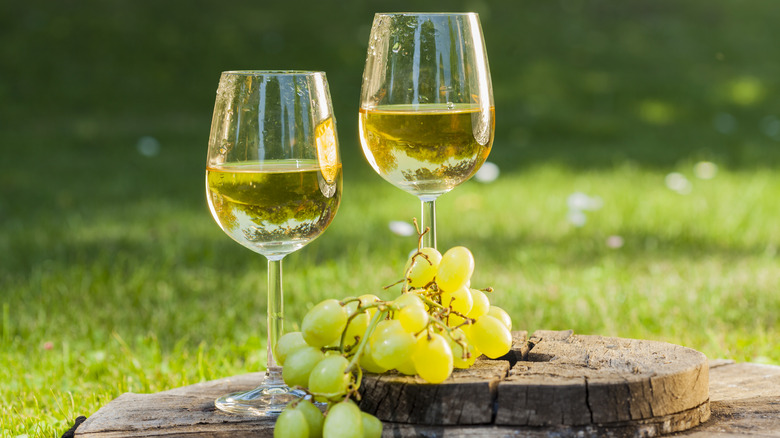Pinot Grigio And Sauvignon Blanc Are More Different Than You'd Think
"Red or white?" is more than an outdated question. It's so far beyond a foodie faux-pas that, if your server asks it at the start of your meal, you can probably expect a lousy dining experience. It's no secret that not all white wines are created equal — which is why today we're deep-diving into what separates two of the most popular, accessible varieties in the modern white wine oeuvre: Pinot grigio and sauvignon blanc.
For starters, it might be helpful to get their commonalities out of the way. Both wines are high-acidity and dry. It'd be tough to confuse either of these varieties with a sweet Riesling or Moscato. They share an ideal serving temperature of 45-55 degrees Fahrenheit (you can overchill wine, for the record), and both clock in at 11.5%-13.5% ABV. Both wines are also (happily) wicked affordable and commonly available in most grocery stores. For those looking to try a high-quality yet still affordable bottle, Costco carries a great sauvignon blanc and pinot grigio.
This is largely where their similarities end. As with any wine, their flavor profiles can vary depending on in which region the wine was produced, and whether it is a mass-batch or single-vineyard product (and within that, the conditions of that year's vintage). But, with a sharpened sense of knowing what to expect, the taste of pinot grigio and the taste of sauvignon blanc couldn't seem further apart in your palate.
What is pinot grigio?
Pinot grigio is made from the eponymous pinot grigio grape, a mutation of pinot noir. The grape itself is surrounded in a pinkish-gray skin responsible for the "grigio" or "gris" in the variety's name, both meaning "gray." The hallmark of pinot grigio is a crisp, dry to medium-dry profile with a light body and low tannins. Zippy acidity and airy citrus top notes combine for a refreshing counterbalance to the dryness. This pale gold beauty finishes with a smooth, rich, silky, lingering mouthfeel. On the palette, top notes often include meyer lemon, lime, peach, pear, apricot, honeysuckle, raw almond, melon, Granny Smith green apple, white nectarine, and salinity.
While wine varieties tend to be organized and subsequently named by region, pinot grigio is a vino well-known and well-loved by fans worldwide. "Pinot grigio" is the wine's Italian name. In France, the same wine is called "pinot gris." Although, an important distinction here: Pinot grigio and pinot gris are not identical, even though colloquially, they are often used interchangeably to refer to the same wine. Alsace-style totes higher tannins and yields a fuller-bodied wine that leans sweeter than its Italian counterpart. Still, the difference is truly marginal enough that to use both regional names interchangeably is not necessarily incorrect.
What is sauvignon blanc?
Like pinot grigio, sauvignon blanc is dry yet refreshing. But, where pinot grigio shines in zesty, bright citrus notes, sauvignon blanc brings the depth with a terroir-driven palette. To be clear, that's "terroir," not "minerality" (more on the new-age wine term debate here). With sauvignon blanc, it's all about herbaceous "greenness" and razor-sharp acidity.
It's a strong-tasting and highly expressive wine, leaning either citrus-fruity (New Zealand-produced sauvignon blancs feature distinctive top notes of dry gooseberry and grapefruit) or savory (vegetal notes of grass, tomato leaf, and bell pepper). That herbal, vegetal flavor comes from a chemical compound called pyrazine, which gives sauvignon blanc its unique, wildly recognizable flavor compared to other high-acid white wines. This semi-aromatic, medium-light-bodied wine is less accessible than pinot grigio, but extremely balanced and with an equally long finish.
Prominent tasting notes include gooseberry, honeydew melon, grapefruit, white peach, and passion fruit. More specific, subtler regional notes can range from beeswax to lemongrass, saline, flint, and pea shoot. Sauvignons blanc also generally features a better aging capacity than pinot grigio, and can be bâtonnaged, a process you're less likely to spy with pinot grigio.
Pinot grigio is dominantly Italian, while sauvignon blanc comes from New Zealand and France
Wine is heavily influenced by its growing region, and as such, the foundational difference between pinot grigio and sauvignon blanc begins with the soil and climate in which they're grown. The Lombardy region in Northern Italy is the most popular, well-known region for pinot grigio production. This area produces consistent, accessible wine that makes up for any lack in dimensionality with affordability. In fact, perhaps counterintuitively, during blind tastings, many sommeliers are able to identify pinot grigio based on its lack of complexity. Beyond Italy, pinot grigio's top two production regions are Oregon's Willamette Valley and Alsace Grand Cru of France. Despite its Italian name, pinot grigio originates from the French grapes of Burgundy, but is also produced today in Trentino-Alto Adige, Umbria, Emilia-Romagna, Friuli, and Austria, among other places.
Like pinot girigio, Sauvignon blanc also originated in Bordeaux (specifically Bordeaux's Pessac-Léognan and Entre-Deux-Mers regions and the Loire Valley) but quickly spread from France thanks to Paris's electric nightlife to vineyards across New Zealand, Africa, Chile, Argentina, California, and Australia. In fact, the "sauvignon" in the wine's title evolves from the French "sauvage" meaning "wild," a nod to how quickly the grape variety rooted and spread across the region. In the modern wine scene, sauvignon blanc's dominant regional identity belongs to New Zealand, where it is most commonly produced in Marlborough.
Pinot grigio is food-pairing friendly, while sauvignon blanc specifically favors herbaceous dishes
Thanks to their unique and vastly different flavor profiles, it's only natural that pinot grigio and sauvignon blanc fare better alongside different food pairings. Pinot grigio pairs famously well with non-tomato pasta dishes like chicken alfredo, shrimp scampi, and any lemon, butter, or pesto sauces (the wine's high acididty makes quick work of cutting through richer sauces). It's also a great match for subtly-flavored seafood like ceviche, tilapia, scallops, oysters, sea bass, salmon, halibut, and sole, as well as spiced meats like pork and duck. Pinot grigio's versatility and relatively uncomplicated profile makes it a good pair for eclectic charcuterie spreads (especially with sheep's milk cheeses like gruyere and manchego), and its bright acidity can round out spicy dishes like green curry or chicken tikka masala.
Sauvignon blanc is a bit bolder and, by extension, requires a bit more intentionality to pair well. This grassy wine complements herb-forward dishes, making it a popular pairing with Thai and Vietnamese culinary stylings, which prominently feature herbaceous flavors. It works well with grassy chèvre cheese, or any soft, flavorful cheese like goat cheese, burrata, ricotta, and crème fraîche. Like most white wines, it's also a good match for light proteins like tofu, chicken, turkey, and seafood, particularly mild-yet-funky trout, calamari, smoked salmon, lobster, and garlic prawns. Other solid food matches include veal picatta, pork chops, woody creamed mushroom risotto, Greek pasta salad, artichokes, eggplants, leeks, zucchini, and asparagus.




